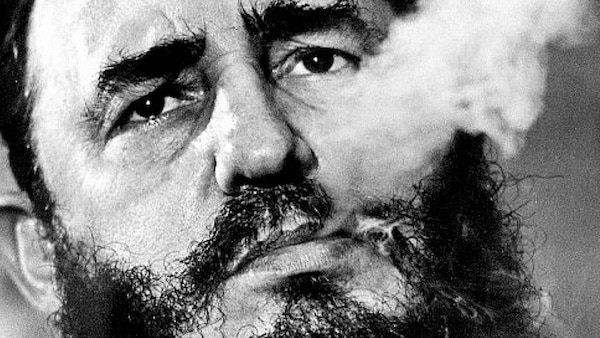I never did another story that gave me more professional satisfaction… I only take credit for having correctly interpreted what I saw and heard, for having realized that the extraordinary young man who opened his heart to me in whispers, for three hours, would be the one around whom the hopes and passions of Cuba would be concentrated, for a tide of victory.

Herbert Matthews interviewing Fidel in the Sierras.
This is how Herbert Matthews, the distinguished American journalist and editorialist who arrived in February 1957 at Epifanio Díaz’s farm, in the vicinity of the Sierra Maestra, to meet with Fidel, responded to his critics.
Days before, the guerrilla leader had instructed the guerrilla to obtain an impact interview with a respected correspondent outside Cuba, but the unexpected betrayal of Eutimio Guerra left Fidel in such a compromised security situation that the visting journalist also was in real danger.
“Without the press, Fidel Castro would be no more than an outlaw… isolated and ineffective,” said Matthews, who, as a profound connoisseur of Cuban and Latin American affairs, suspected that behind the iron censorship ordered by Batista in Cuba, there was a well-kept secret that was waiting to be told.
In Refugio 106, the former offices of The New York Times in Havana, the possibility of the famous U.S. newspaper obtaining the exclusive of the moment was discussed for the first time: “Fidel is alive”. Ruby Hart Phillips, the paper’s snooty correspondent in Cuba, would professionally keep the secret.
The arrival of Herbert and his wife Nancie hours later in the Cuban capital ratified the willingness of the newspaper’s editors to run the tremendous risk of going into the eastern mountains in search of that news. Everyone expected Matthews to reveal the name of the young journalist who would undertake the risky assignment, but they were surprised when he smilingly said:
I will go up there myself.
A well-oiled network of collaborators of the July 26th movement throughout the Island would be in charge of taking him to Fidel. The days would be hard for him and Nancie, undercover as American tourists interested in investing in the eastern zone.
Many years later a specialist in Psychological Operations of the U.S. Army Southern Command would write:
The propaganda and political warfare of the Cuban Revolution, when examined in its original context, illustrate a well-planned and executed psychological operation that influenced numerous audiences and led to behavioral changes that ended up helping Fidel Castro take power, while commanding a numerically and technologically inferior force.
All kinds of reactions were generated by that front page of The New York Times’ Sunday paper on February 24, 1957. In the Presidential Palace they wondered how Matthews, now close to 60 years of age and under the prescription of his cardiologist, had managed to withstand the rigors of that journey and overcome the postures of the Batista troops in the Sierra, trained and armed by the United States.
Edmund Chester, an American, former journalist of the Associated Press and CBS television, then hired as Batista’s press secretary and advisor for his speeches, superficially concluded that it was a trick of his experienced “colleague” and recommended the regrettable denial in the pen of the then Secretary of Defense, Santiago Verdeja, published by Bohemia Magazine.
At Calzada 55, the advisors of Arthur Gardner, U.S. ambassador in Havana and a fraternal friend of Batista, refused to admit that they had not heard anything. Gardner’s fury would be such that, already replaced and disqualified, he would devote much energy to ruin Matthews’ professional career.
Despite censorship and threats here and there, the three articles resulting from Matthews’ interview with Fidel spread like wildfire. The major U.S. newspapers ran versions of the interview, the nascent television reported it exclusively and an army of journalists began to plan their next trip to the Sierra Maestra.
From that moment until November 25, 2016, the media in the U.S. did not stop monitoring Fidel’s trajectory. They followed him at every step. His meeting with Herbert Matthews would be but the first of many memorable exchanges with the main U.S. opinion leaders, whom he turned, without telling them, into the people who would explain the Revolution to the audience of the irate adversary.
As the Revolution concretized the Moncada program, Cuba’s enemies attacked Matthews mercilessly, holding him responsible for the new destinies of the island and even undeservedly claiming that he “invented Fidel”.
The unrepeatable Ernest Hemingway, his friend since the dark nights of fire and death shared during the Spanish Civil War, would write:
Herbert Matthews is the most severe, the most capable and the bravest of today’s war correspondents, he has seen the truth where it has been most dangerous to see it… he stands today as a giant beacon of honesty…
Guillermo Suárez Borges is a researcher with the International Policy Research Center (CIPI) in Havana, Cuba.

